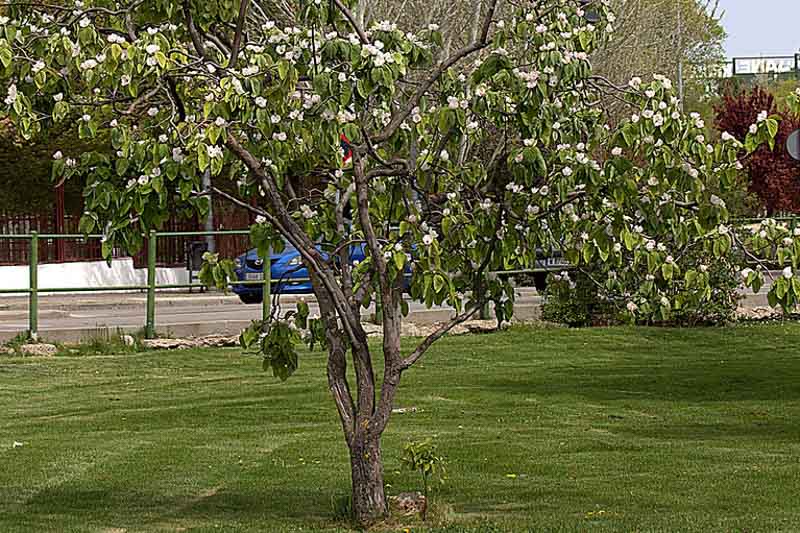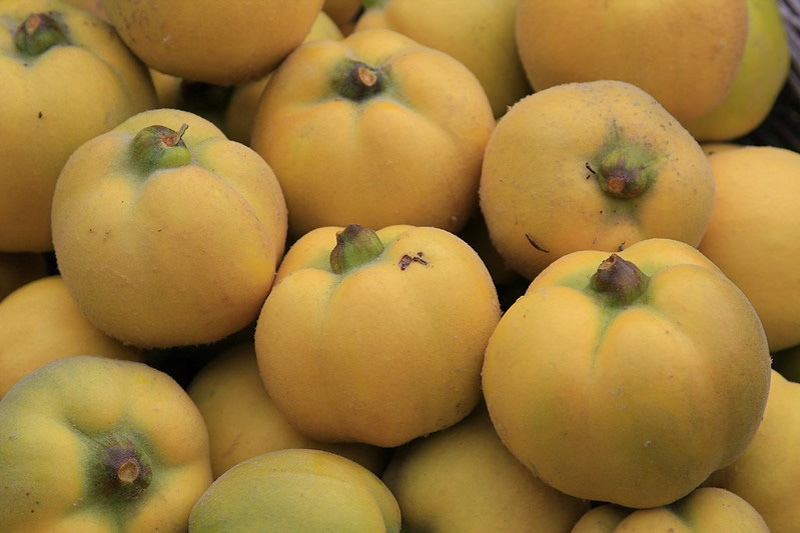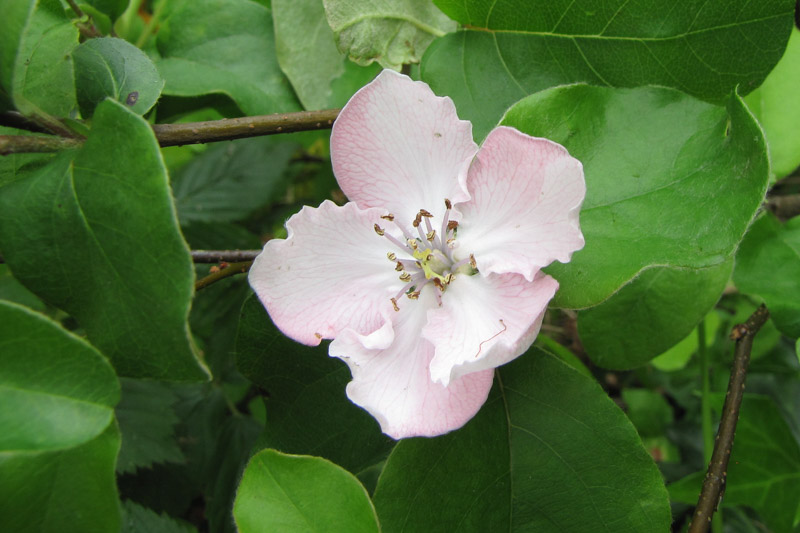Cydonia oblonga, commonly known as quince, is a deciduous tree or large shrub that boasts a unique combination of fragrant pinkish-white flowers and pale yellow, pome-like fruit. Its knobby, irregular bark and twisted branches add to its picturesque appearance.
Cydonia oblonga: The Enchanting Quince
Native: Originating from the Caucasus region and stretching to parts of Turkey and Iran, quince has a long history of cultivation, dating back to ancient Greece and Rome.
Habit: Quince typically grows with a naturally bushy and dense habit, sometimes more tree-like when mature and pruned for that purpose.
Size: Quince grows slowly to a height of 10-20 feet (3-6 meters) with a similar spread, making it a medium-sized specimen suitable for various garden sizes.
Flowers: In spring, quince graces gardens with lovely pinkish-white flowers, 2 inches across (5 cm) that resemble those of its relatives, apples and pears.
Bloom Time: The blossoms emerge in mid to late spring, usually from April to May, depending on the local climate.
Fruit: By autumn, the aromatic pale yellow fruits mature. Quinces are not typically eaten raw, unlike other fruits due to their tartness and hard texture. However, they transform into flavorful jellies, jams, and other culinary delights when cooked.
Hardiness: Quince is hardy in USDA zones 5 through 9, making it a versatile plant for various climates.
Uses: Beyond its culinary applications, quince serves as an ornamental specimen in gardens. Its twisted branches make it a winter attraction, and its fragrant flowers and fruit offer multi-season interest. Quince is also one of the most popular species for deciduous bonsai specimens. Historically, it has been used in traditional medicines for digestive issues.
Wildlife: Birds are attracted to the fruits, and bees or butterflies often visit the flowers, making quince a valuable plant for supporting local ecosystems.
Deer and Rabbits: Deer are attracted by the fragrant fruit. Rabbits could potentially gnaw on the lower branches and bark.
Toxicity: Quince seeds contain nitriles, which can be hydrolyzed to produce toxic hydrogen cyanide. While the fruit flesh is safe to consume, it’s best to avoid the seeds.
Symbol: Its cultural significance spans centuries, often symbolizing fertility and love in ancient texts.
In gardening, quince acts as a conversation starter due to its less common presence compared to other fruiting trees. With its history, beauty, and unique fruit, quince truly is a garden gem waiting to be discovered.

Fruiting Quince: Any Health Benefits?
Quince is a fruit that has been cultivated since ancient times, and while not as popular in modern Western diets, it holds a cherished place in many cultures for its culinary and medicinal uses. The health benefits of quince are derived from its rich nutrient content and bioactive compounds.
Nutrients: Quinces are a nutritious addition to your diet, containing fiber and essential vitamins and minerals. A 3.2-ounce (92-gram) quince provides 52 calories, 14 grams of carbs, 1.75 grams of fiber, and notable amounts of vitamin C (15% of the DV), copper (13% of the DV), iron (3.6% of the DV), potassium, and magnesium. While not exceptionally high in any one nutrient, quinces offer a diverse range of beneficial compounds for minimal calories.
- Rich in Fiber: Quinces are a good source of dietary fiber, which supports digestive health, regulates bowel movements, and may help manage weight.
- Vitamin C: Quinces contain vitamin C, an antioxidant that boosts the immune system, promotes skin health, and aids in wound healing.
- Mineral Content: Quinces provide minerals like copper, iron, potassium, and magnesium, essential for proper bodily functions, including nerve transmission and muscle contraction.
- Antioxidants: Quinces contain antioxidants that help combat oxidative stress, reducing the risk of chronic diseases and promoting overall well-being.
- Anti-Inflammatory Properties: Compounds in quinces have potential anti-inflammatory effects, contributing to reduced inflammation in the body.
- Digestive Benefits: Quinces are known for their potential to alleviate digestive issues, such as stomach discomfort and diarrhea.
- Potential Anti-Cancer Effects: Some studies suggest that quinces may have compounds with anti-cancer properties, although more research is needed.
- Heart Health: Quinces’ fiber and potassium content can contribute to heart health by supporting healthy blood pressure levels and reducing cholesterol.
While quince offers numerous health benefits, it’s essential to incorporate it into a balanced diet and not view it as a cure-all.
As with any food or herbal remedy, individuals should consult with healthcare professionals before using quince for medicinal purposes, especially if they have existing health conditions or are on medications.

How to Eat Quince?
Quince is a unique fruit that is rarely eaten raw due to its tartness and hard texture. However, when cooked, quince transforms both in texture and flavor, becoming soft, aromatic, and delicious. Here’s how you can enjoy quince:
- Quince Jelly or Jam: Quince is high in natural pectin, making it ideal for jellies and jams. Simply core and chop the quince, boil it until soft, then strain and cook the liquid with sugar until it sets.
- Quince Paste (Membrillo): This thick, sweet paste is a Spanish delicacy often served with cheese. To make it, boil quince pieces until they’re soft, then purée and cook with sugar until thickened.
- Quince Tarts or Pies: Much like apples or pears, quince can be used as a filling for pies and tarts. They’re typically precooked with sugar before baking.
- Baked or Roasted Quince: Slice the quince, sprinkle with sugar and spices like cinnamon or nutmeg, and bake until they’re soft and golden. Roasted quince pairs wonderfully with meats like pork or lamb.
- Quince Stew: In some Middle Eastern cuisines, quince is added to stews along with meats for a delightful sweet and savory combination.
- Quince Compote: Cook quince pieces with sugar, water, and spices until they become soft. This compote can be served with yogurt, ice cream, or on its own.
- Quince Wine or Liqueur: In some cultures, quince is fermented to make wine or used to produce aromatic liqueurs.
- Poached Quince: Quince can be poached in a sugar syrup infused with vanilla, citrus zest, or spices until soft. The resulting fruit is delicious and the syrup becomes a quince-flavored treat on its own.
- Quince Sauce: A variation of applesauce, quinces can be boiled, mashed, and sweetened to taste. It can serve as a side or be used in baked goods.
- Fresh Quince: Though uncommon due to its astringency, some people enjoy raw quince with a sprinkle of salt or chili powder. It’s crunchy and has a flavor reminiscent of a tart apple.
Tips:
- When preparing quince, you’ll notice that its pale flesh quickly turns brown when exposed to air. To prevent this, you can immerse the cut pieces in a bowl of water with a bit of lemon juice.
- Quince has a rigid core and many seeds, typically removed before cooking.
- The aroma of quince is delightful. Even if you don’t eat them right away, having a bowl of quince in your home can serve as a natural air freshener.
While quince might not be the first choice for a raw snack, its versatility in cooking makes it a valuable fruit in the culinary world. Its transformation from hard and tart to soft and sweet showcases the magic of cooking!

How to Grow and Care for Quince?
Quince trees are relatively easy to grow.
Site Selection
- Sunlight: Plant quince trees in full sun. They need at least six hours of sunlight daily to produce quality fruit. They tolerate part shade but best flower production occurs in full sun.
- Soil: Quince prefers deep, fertile, well-draining soil with a pH of 6.0-7.5. While they can tolerate a variety of soil types, avoid heavy clay soils that retain too much water.
Planting
- Spacing: Space quince trees 10-15 feet (3-4.5 meters) apart.
- Depth: Dig a hole twice as wide as the root ball and the same depth. Place the tree in the hole and backfill it with soil, ensuring the graft union is above the soil line.
Watering
- Water newly planted trees regularly to keep the soil moist but not waterlogged. Once established, quince trees can tolerate short periods of drought, but regular watering during dry spells will improve fruit yield and quality.
Fertilizing
- In the first year, once new growth appears, you can apply a balanced fertilizer. In subsequent years, fertilize in the spring, before new growth starts.
Pruning
- Prune quince trees to maintain an open, vase-like shape which allows sunlight to penetrate and air to circulate. This shape reduces the risk of fungal diseases.
- Pruning should occur after the last frost of the year when the plant is still dormant.
- Remove any dead, diseased, or crossing branches during the dormant season.
Harvesting
- Quince is typically ready to harvest in late autumn when the fruit turns from green to golden yellow.
- Unlike other fruits, quince is hard and tart when raw and is usually cooked to bring out its sweetness and aroma.
Additional Care
- Mulching around the base of the tree can help conserve moisture, suppress weeds, and regulate soil temperature.
- Protect young trees from deer and rodents by placing guards around the trunk.
How to Propagate Quince
Propagation of Cydonia oblonga (quince) can be done through several methods, including seed germination, hardwood cuttings, layering, and grafting. Each method has its pros and cons, and the choice of method often depends on the available resources, time, and desired characteristics of the propagated plants.
Seed Germination
- Collect seeds from mature quince fruits.
- Clean the seeds and stratify them in moist sand or peat moss in a sealed container in the refrigerator for about 4-6 weeks.
- Sow stratified seeds in a seed-starting mix and keep the soil moist.
- Pros: Simple and doesn’t require special tools.
- Cons: Seedlings may not be true to the parent plant, and it will take several years for the plant to bear fruit.
Hardwood Cuttings
- Take hardwood cuttings of 6-12 inches (15-30 cm) in length during the dormant season, typically late winter.
- Dip the cut end in rooting hormone.
- Plant the cutting in a pot filled with a mix of sand and peat, or directly in the ground.
- Keep the soil moist but not waterlogged.
- Pros: Relatively simple, and the plant will be genetically identical to the parent.
- Cons: Not all cuttings may root successfully.
Layering
- Select a low-growing branch and bend it to the ground.
- Make a small cut or nick on the branch where it touches the soil.
- Bury the cut/nicked part of the branch in the soil and secure it with a stone or peg.
- After roots develop (this can take several months to a year), cut the new plant from the parent plant and transplant it.
- Pros: High success rate and the new plant is genetically identical to the parent.
- Cons: Takes longer to produce a new plant.
Common Problems with Fruiting Quince
Quince (Cydonia oblonga) is a fruit-bearing tree that is related to apples and pears. Though it’s less commonly grown than its relatives, quince is appreciated for its fragrant fruit and attractive blossoms. However, like any other plant, quince trees can experience a range of problems, both in terms of pests and diseases as well as cultural challenges. Here are some common problems associated with fruiting quince:
Pest Problems
- Quince Fruit Sawfly:
- Description: The larvae of this pest bore into the fruits, leading to rotting from the inside.
- Management: Introduce beneficial insects like parasitic wasps, or use insecticidal soaps or sprays at first sign of infestation.
- Codling Moth:
- Description: Caterpillars burrow into quince fruit, resulting in brown, wormy fruit.
- Management: Pheromone traps can be used to reduce the male population, and insecticides can be applied during specific growth stages.
- Aphids:
- Description: Tiny insects that suck sap from the leaves and might lead to the development of sooty mold.
- Management: Introduce beneficial insects like ladybugs or apply insecticidal soaps or neem oil.
Diseases
- Quince Leaf Blight:
- Description: A fungal disease causing red spots on leaves followed by premature leaf drop.
- Management: Ensure good air circulation and avoid wetting leaves during irrigation. Apply appropriate fungicides.
- Fire Blight:
- Description: Bacterial disease causing branches to blacken and appear as if scorched.
- Management: Prune affected branches well below the infection zone and sterilize pruning tools.
- Brown Rot:
- Description: Fungal disease where the fruit rots on the tree.
- Management: Regularly remove and dispose of affected fruits. Apply fungicides when conditions favor disease.
- Powdery Mildew:
- Description: White to gray powdery spots on leaves, fruit, and stems.
- Management: Increase air circulation, water plants at the soil level, and apply fungicides when necessary.
- Honey Fungus:
- Description: A soil-borne fungus affecting roots and the base of the trunk, leading to overall tree decline.
- Management: Remove infected trees, improve soil drainage, and create physical barriers to prevent spread.
Cultural and Environmental Challenges
- Water Stress:
- Description: Inconsistent watering can lead to various issues, including poor fruit quality.
- Management: Maintain consistent moisture, especially during fruit development. Mulch can help retain soil moisture.
- Poor Pollination:
- Description: Lack of fruit set due to insufficient pollination.
- Management: Ensure presence of pollinators or hand-pollinate if needed. Planting multiple trees can also help.
- Frost Damage:
- Description: Late frosts can damage blossoms and young fruits.
- Management: If possible, protect trees during frost-prone nights using frost cloths or by spraying water on the tree to raise the ambient temperature.
Physical Damage
- Fruit Splitting:
- Description: Caused by irregular watering or sudden weather changes.
- Management: Ensure consistent watering, especially as fruit matures.
Fruit Set Issues
- Insufficient Pollination:
- Description: Quince trees might produce plenty of flowers, but if these flowers are not pollinated, they will not set fruit. This can be due to a lack of pollinators, adverse weather during the flowering period, or if a specific variety of quince requires cross-pollination.
- Management:
- Plant multiple quince trees to ensure cross-pollination.
- Promote bee activity by planting bee-friendly flowers nearby.
- Avoid using pesticides during flowering, as they can deter or kill pollinators.
- In areas with very low bee activity, consider hand-pollinating using a soft brush.
- Biennial Bearing:
- Description: Some quince trees have a tendency to bear heavily in one year and produce little to no fruit in the next, a phenomenon known as biennial bearing.
- Management:
- Thinning fruit in a heavy crop year can help in breaking the cycle. By reducing the load, the tree might not go into the “resting” phase the following year.
- Ensure consistent and proper fertilization and watering to provide the tree with the resources it needs every year.
- Frost Damage:
- Description: Late spring frosts can damage or kill the blossoms of quince trees, leading to poor fruit set.
- Management:
- Choose a frost-resistant variety if you’re in an area prone to late frosts.
- Protect blossoms during frost-prone nights using frost cloths or by spraying water on the tree to raise the ambient temperature.
- Planting quince trees in a location that doesn’t get early morning sun can also help, as rapid thawing of frost can damage the flowers.
- Nutritional Imbalances:
- Description: A lack of essential nutrients, especially potassium and boron, can affect fruit set.
- Management:
- Regularly test soil to ensure it has a balanced nutrient profile.
- Use a balanced fertilizer or apply specific nutrients if deficiencies are identified.
- Pest or Disease Damage:
- Description: Certain pests or diseases can affect the flowers or young fruit, causing them to drop prematurely.
- Management:
- Regular monitoring for pests and diseases and timely management can prevent or reduce damage.
- Following integrated pest management (IPM) practices can help in maintaining a balance.
- Water Stress:
- Description: Both under-watering and over-watering can lead to flower drop or poor fruit set.
- Management:
- Ensure consistent moisture, especially during the flowering and fruit set period.
- Mulching can help maintain consistent soil moisture.
Overall, understanding the specific cause of poor fruit set in your quince trees will guide the best management practices. Regular monitoring and providing optimal growing conditions are key to achieving consistent and bountiful harvests.
While every effort has been made to describe these plants accurately, please keep in mind that height, bloom time, and color may differ in various climates. The description of these plants has been written based on numerous outside resources.


